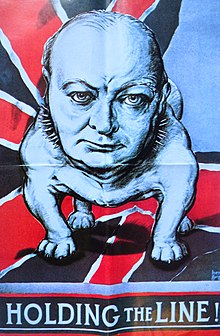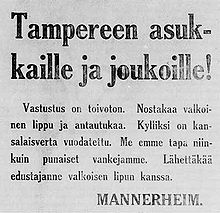User:Blakemurray7/sandbox
References[edit]
Vaping has a negative effects upon lungs of those who inhale it and causes DAH (Diffuse Alveolar Hemorrhage).[1]
 | This is a user sandbox of Blakemurray7. You can use it for testing or practicing edits. This is not the sandbox where you should draft your assigned article for a dashboard.wikiedu.org course. To find the right sandbox for your assignment, visit your Dashboard course page and follow the Sandbox Draft link for your assigned article in the My Articles section. |
- ^ collegeofidaho.on.worldcat.org https://collegeofidaho.on.worldcat.org/search/detail/8254044096?queryString=vaping%20effects%20the%20lungs&clusterResults=true&stickyFacetsChecked=true&groupVariantRecords=false. Retrieved 2022-02-20.
{{cite web}}: Missing or empty|title=(help)
History[edit]

Primitive forms of propaganda have been a human activity as far back as reliable recorded evidence exists. The Behistun Inscription (c. 515 BC) detailing the rise of Darius I to the Persian throne is viewed by most historians as an early example of propaganda.[1] Another striking example of propaganda during ancient history is the last Roman civil wars (44–30 BC) during which Octavian and Mark Antony blamed each other for obscure and degrading origins, cruelty, cowardice, oratorical and literary incompetence, debaucheries, luxury, drunkenness and other slanders.[2] This defamation took the form of uituperatio (Roman rhetorical genre of the invective) which was decisive for shaping the Roman public opinion at this time. Another early example of propaganda was from Genghis Khan. The emperor would send some of his men ahead of his army to spread rumors to the enemy. In most cases, his army was actually smaller than some of his opponents'.[3]

Holy Roman Emperor Maximilian I was the first ruler to utilize the power of the printing press for propaganda - in order to build his image, stir up patriotic feelings in the population of his empire (he was the first ruler who utilized one-sided battle reports – the early predecessors of modern newspapers or neue zeitungen – targeting the mass.[4][5]) and influence the population of his enemies.[6][7][8] Propaganda during the Reformation, helped by the spread of the printing press throughout Europe, and in particular within Germany, caused new ideas, thoughts, and doctrine to be made available to the public in ways that had never been seen before the 16th century. During the era of the American Revolution, the American colonies had a flourishing network of newspapers and printers who specialized in the topic on behalf of the Patriots (and to a lesser extent on behalf of the Loyalists).[9] Academic Barbara Diggs-Brown conceives that the negative connotations of the term “propaganda” are associated with the earlier social and political transformations that occurred during the French Revolutionary period movement of 1789 to 1799 between the start and the middle portion of the 19th century, in a time where the word started to be used in a nonclerical and political context.[10]

The first large-scale and organised propagation of government propaganda was occasioned by the outbreak of the First World War in 1914. After the defeat of Germany, military officials such as General Erich Ludendorff suggested that British propaganda had been instrumental in their defeat. Adolf Hitler came to echo this view, believing that it had been a primary cause of the collapse of morale and revolts in the German home front and Navy in 1918 (see also: Dolchstoßlegende). In Mein Kampf (1925) Hitler expounded his theory of propaganda, which provided a powerful base for his rise to power in 1933. Historian Robert Ensor explains that "Hitler...puts no limit on what can be done by propaganda; people will believe anything, provided they are told it often enough and emphatically enough, and that contradicters are either silenced or smothered in calumny."[11] This was to be true in Germany and backed up with their army making it difficult to allow other propaganda to flow in.[12] Most propaganda in Nazi Germany was produced by the Ministry of Public Enlightenment and Propaganda under Joseph Goebbels. Goebbels mentions propaganda as a way to see through the masses. Symbols are used towards propaganda such as justice, liberty and one's devotion to one's country.[13] World War II saw continued use of propaganda as a weapon of war, building on the experience of WWI, by Goebbels and the British Political Warfare Executive, as well as the United States Office of War Information.[14]
In the early 20th century, the invention of motion pictures (as in movies, diafilms) gave propaganda-creators a powerful tool for advancing political and military interests when it came to reaching a broad segment of the population and creating consent or encouraging rejection of the real or imagined enemy. In the years following the October Revolution of 1917, the Soviet government sponsored the Russian film industry with the purpose of making propaganda films (e.g., the 1925 film The Battleship Potemkin glorifies Communist ideals). In WWII, Nazi filmmakers produced highly emotional films to create popular support for occupying the Sudetenland and attacking Poland. The 1930s and 1940s, which saw the rise of totalitarian states and the Second World War, are arguably the "Golden Age of Propaganda". Leni Riefenstahl, a filmmaker working in Nazi Germany, created one of the best-known propaganda movies, Triumph of the Will. In 1942, the propaganda song Niet Molotoff was made in Finland during the Continuation War, making fun of the Red Army's failure in the Winter War, referring the song's name to the Soviet's Minister of Foreign Affairs, Vyacheslav Molotov.[15] In the US, animation became popular, especially for winning over youthful audiences and aiding the U.S. war effort, e.g.,Der Fuehrer's Face (1942), which ridicules Hitler and advocates the value of freedom. Some American war films in the early 1940s were designed to create a patriotic mindset and convince viewers that sacrifices needed to be made to defeat the Axis Powers.[16] Others were intended to help Americans understand their Allies in general, as in films like Know Your Ally: Britain and Our Greek Allies. Apart from its war films, Hollywood did its part to boost American morale in a film intended to show how stars of stage and screen who remained on the home front were doing their part not just in their labors, but also in their understanding that a variety of peoples worked together against the Axis menace: Stage Door Canteen (1943) features one segment meant to dispel Americans' mistrust of the Soviets, and another to dispel their bigotry against the Chinese. Polish filmmakers in Great Britain created the anti-Nazi color film Calling Mr. Smith[17][18] (1943) about Nazi crimes in German-occupied Europe and about lies of Nazi propaganda.[19]
The West and the Soviet Union both used propaganda extensively during the Cold War. Both sides used film, television, and radio programming to influence their own citizens, each other, and Third World nations. Through a front organization called the Bedford Publishing Company, the CIA through a covert department called the Office of Policy Coordination disseminated over 1 million books to Soviet readers over the span of 15 years, including novels by George Orwell, Albert Camus, Vladimir Nabakov, James Joyce, and Pasternak in an attempt to promote anti-communist sentiment and sympathy of Western values.[20] George Orwell's contemporaneous novels Animal Farm and Nineteen Eighty-Four portray the use of propaganda in fictional dystopian societies. During the Cuban Revolution, Fidel Castro stressed the importance of propaganda.[21][better source needed] Propaganda was used extensively by Communist forces in the Vietnam War as means of controlling people's opinions.[22]
During the Yugoslav wars, propaganda was used as a military strategy by governments of Federal Republic of Yugoslavia and Croatia. Propaganda was used to create fear and hatred, and particularly to incite the Serb population against the other ethnicities (Bosniaks, Croats, Albanians and other non-Serbs). Serb media made a great effort in justifying, revising or denying mass war crimes committed by Serb forces during these wars.[23]
In the modern day propaganda has become more effective and widespread in being used in more non-traditional ways against a wider array of people.
- ^ Nagle, D. Brendan; Stanley M Burstein (2009). The Ancient World: Readings in Social and Cultural History. Pearson Education. p. 133. ISBN 978-0-205-69187-6.
- ^ Borgies, Loïc (2016). Le conflit propagandiste entre Octavien et Marc Antoine. De l'usage politique de la uituperatio entre 44 et 30 a. C. n. ISBN 978-90-429-3459-7.
- ^ Davison, W. Phillips (1971). "Some Trends in International Propaganda". The Annals of the American Academy of Political and Social Science. 398: 1–13. doi:10.1177/000271627139800102. ISSN 0002-7162. JSTOR 1038915. S2CID 145332403.
- ^ Kunczic, Michael (9 August 2016). "Public Relations in Kriegzeiten – Die Notwendigkeit von Lüge und Zensur". In Preußer, Heinz-Peter (ed.). Krieg in den Medien (in German). BRILL. p. 242. ISBN 978-94-012-0230-5. Retrieved 7 February 2022.
- ^ Kunczik, Michael (6 May 2016). Images of Nations and International Public Relations. Routledge. p. 158. ISBN 978-1-136-68902-4. Retrieved 7 February 2022.
- ^ Museum, Cincinnati Art; Becker, David P. (1993). Six Centuries of Master Prints: Treasures from the Herbert Greer French Collection. Cincinnati Art Museum. p. 68. ISBN 978-0-931537-15-8. Retrieved 7 February 2022.
- ^ Silver, Larry (2008). Marketing Maximilian: The Visual Ideology of a Holy Roman Emperor. Princeton University Press. p. 235. ISBN 978-0-691-13019-4. Retrieved 7 February 2022.
- ^ Füssel, Stephan (29 January 2020). Gutenberg and the Impact of Printing. Routledge. pp. 10–12. ISBN 978-1-351-93187-8. Retrieved 7 February 2022.
- ^ Cole, Richard G. (1975). "The Reformation in Print: German Pamphlets and Propaganda". Archive for Reformation History. 66: 93–102. doi:10.14315/arg-1975-jg07. S2CID 163518886.
- ^ Diggs-Brown, Barbara (2011). Cengage Advantage Books: Strategic Public Relations: An Audience-Focused Approach. Cengage Learning. p. 48. ISBN 978-0-534-63706-4.
- ^ Robert Ensor in David Thomson, ed., The New Cambridge Modern History: volume XII The Era of Violence 1890–1945 (1st edition 1960), p 84.
- ^ Yourman, Julius (November 1939). "Propaganda Techniques Within Nazi Germany". Journal of Educational Sociology. 13 (3): 148–163. doi:10.2307/2262307. JSTOR 2262307.
- ^ Cantril, Hadley (1938). "Propaganda Analysis". The English Journal. 27 (3): 217–221. doi:10.2307/806063. JSTOR 806063.
- ^ Fox, J. C., 2007, "Film propaganda in Britain and Nazi Germany : World War II cinema.", Oxford:Berg.
- ^ "Fono.fi – Äänitetietokanta". www.fono.fi (in Finnish). Retrieved 13 March 2020.
- ^ Philip M. Taylor, 1990, "Munitions of the mind: A history of propaganda”, Pg. 170.
- ^ "Calling Mr. Smith – LUX".
- ^ "Calling Mr Smith". Centre Pompidou.
- ^ "Franciszka and Stefan Themerson: Calling Mr. Smith (1943) – artincinema". 21 June 2015.
- ^ Nick Romeo (17 June 2014). "Is Literature 'the Most Important Weapon of Propaganda'?". Retrieved 28 February 2022.
- ^ prudentiapolitica (20 May 2014). "Prudentia Politica". Retrieved 6 March 2015.
- ^ Sophana Srichampa (30 August 2007). "Vietnamese propaganda reflections from 1945 to 2000" (PDF). Mon-Khmer Studies. 37. Thailand: Mahidol University: 87–116.
- ^ "Serbian Propaganda: A Closer Look". 12 April 1999.
NOAH ADAMS: The European Center for War, Peace and the News Media, based in London, has received word from Belgrade that no pictures of mass Albanian refugees have been shown at all, and that the Kosovo humanitarian catastrophe is only referred to as the one made up or over-emphasised by Western propaganda.
